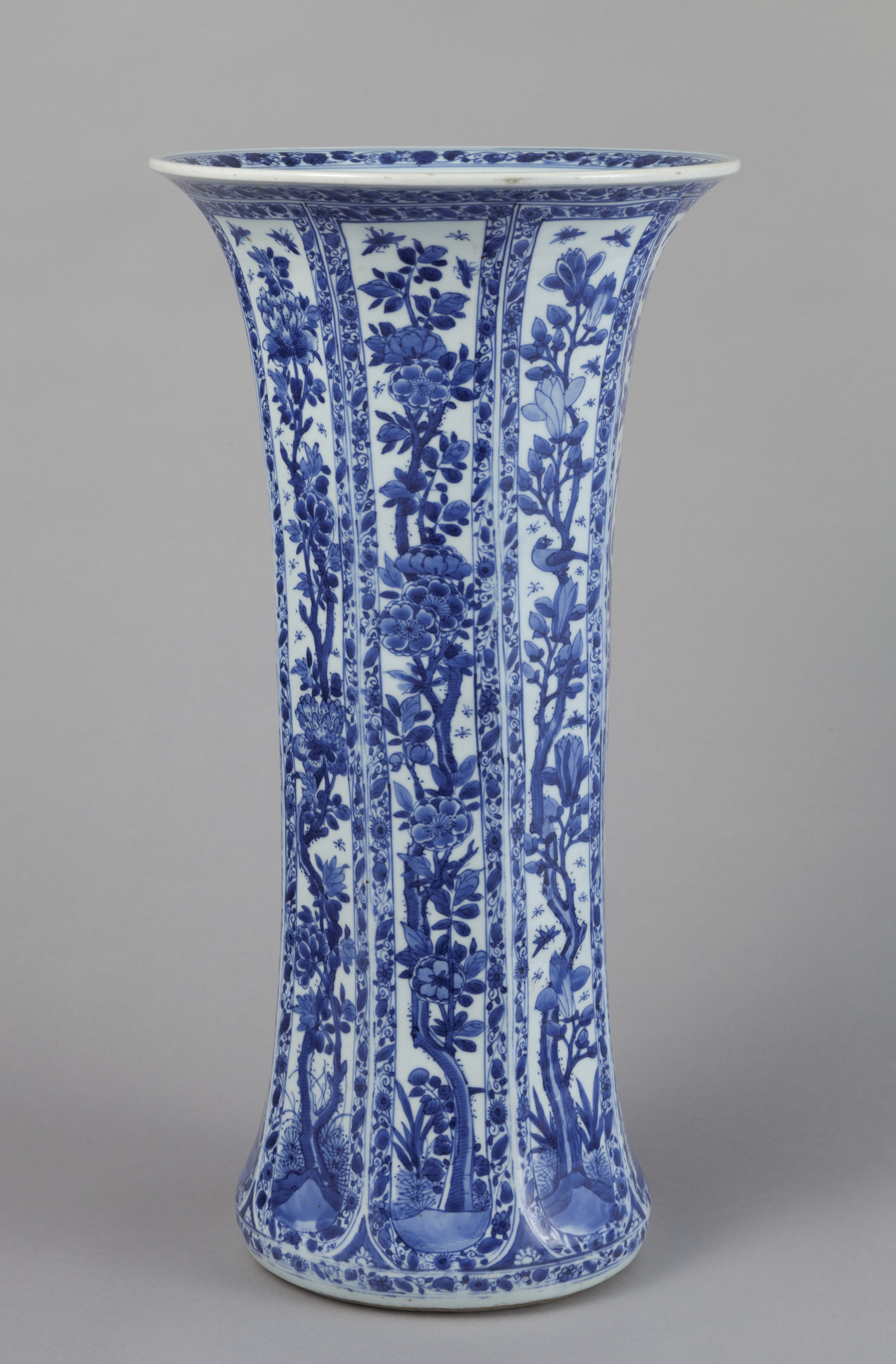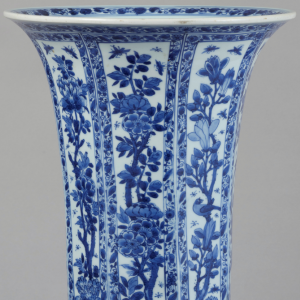Garniture set
Author: Unknown
Origin: Jingdezhen Kilns, China
Dating: 17th-18th century
Material: Porcelain
Dimensions (cm): 52,4 x Ø 27,2
Inv. no.: PD0399
The term “garniture” (garniture-de-cheminée in French) refers to a set of ceramic pieces, typically odd in number. They were commonly used to decorate either fireplaces – as they were placed on the shelf that they usually had – or to top Dutch cabinets or cupboards – which had a proper notch to place these types of pieces.
It is believed that porcelain garnitures from China were ordered for the Dutch market. They were produced by Chinese potters, but decorated with European motifs, characteristic of the taste of the time.
The decoration, painted in blue under the glaze, is divided into eight panels, decorated with chrysanthemums and artemisia leaves, which emphasize the octagonal shape of the piece and frame the panels. The panels are filled with pomegranate branches, blossoming plum branches, arborescent peonies branched like a tree and magnolia branches, all flown over by birds and insects.
“Flora in the Palace’s Collections”
«Due to the multiplicity of fruits that make up the genus Prunus – that bloom and bear fruit in China and that can be apricots, peaches, plums and even cherries Prunus psedocerasus – it becomes difficult to find the name by which a flower or fruit should be called in Portuguese. The fruit of the tree in question – Prunus mume – which is generally called a plum, is, in fact, part of the apricot variety.
The tree may live to a very advanced age, for there are specimens planted in gardens and temples dating back around a thousand years. In China, its flowers are considered “the most beautiful of all”. Their five petals – slightly heart shaped – according to classical Chinese philosophy, allude to the five greatest gifts that can be obtained in this world: health, fortune, a long life, love of virtue and a peaceful death.
[…]
Of the fruit trees, Prunus mume is the first to bloom in late winter – surpassing trees of early cherry – with its buds and tender petals emerging from the bare branches, without a trace of any leaves. In this way – as it is associated with the end of the cold season and the dawn of spring – the tree symbolizes the strength of persistence and hope for the future. However, the flower petals quickly fade, [making them] even more beautiful – even when stripped to the ground and swept by the wind – in a metaphor for the ambivalence of life that (at the same time) embraces the pleasure of beautiful things and the longing for what has been.
Prunus mume or méi – the flower’s popular name in Chinese – bears, by definition, the meaning beautiful. Although floral arrangements and the art of the language of flowers may display several types of plants – as we know today through Ikebana in Japan – the display of branches and flowers of Prunus mume in China, traditionally occurs singularly: in porcelain vases called méipíng, deriving from the name of the flower.
From an ancient type of stoneware container used to hold wine, artisans, in the Song dynasty, created one of the most classic and elegant forms of Chinese porcelain – a narrow-based jar that rises to form a slightly wider and more graceful body with rounded shoulders [and] with a small neck where only a single branch of the tree [would be] set.
[…]
[The] garniture set, which dates from the 17th or 18th centuries, [displays] a decoration of various flowers, including those of Prunus mume. Several dragonflies flutter around the flowers, suggesting the strong fragrance that attracts the insects. A magpie is perched on one of the branches, conveying wishes associated with happiness and joy, expressing […] “good news will come in double” for the flowers are the harbinger of the approaching spring and the magpies are considered doubly auspicious by the homophony of the two morphemes that make up their name xiquè with other morphemes, xi = joy and què = imminent fortune.»
Sasha Assis Lima





